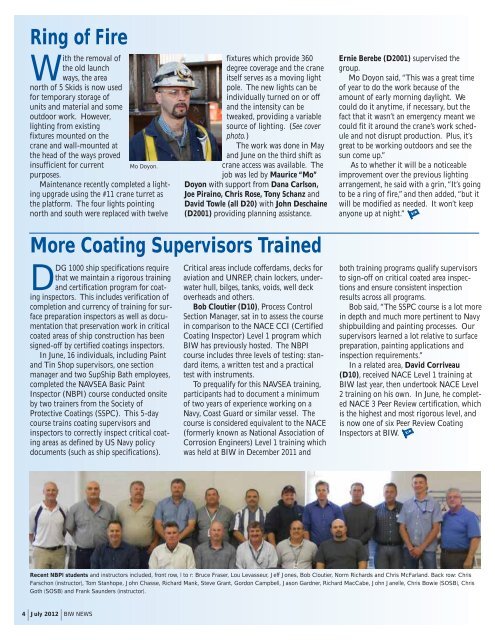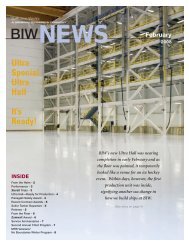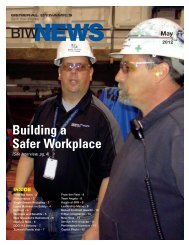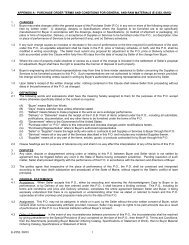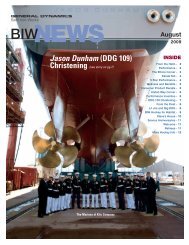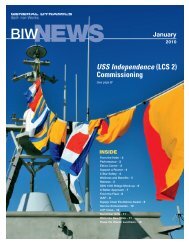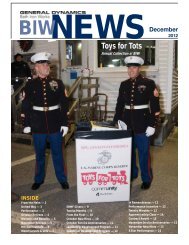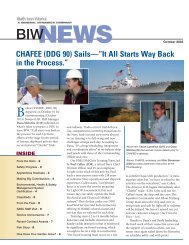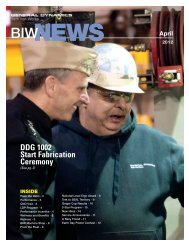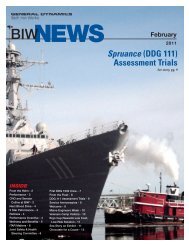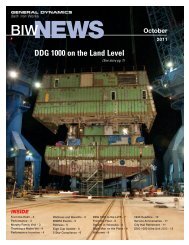JUL - Bath Iron Works
JUL - Bath Iron Works
JUL - Bath Iron Works
Create successful ePaper yourself
Turn your PDF publications into a flip-book with our unique Google optimized e-Paper software.
Ring of Fire<br />
With the removal of<br />
the old launch<br />
ways, the area<br />
north of 5 Skids is now used<br />
for temporary storage of<br />
units and material and some<br />
outdoor work. However,<br />
lighting from existing<br />
fixtures mounted on the<br />
crane and wall-mounted at<br />
the head of the ways proved<br />
insufficient for current Mo Doyon.<br />
purposes.<br />
Maintenance recently completed a lighting<br />
upgrade using the #11 crane turret as<br />
the platform. The four lights pointing<br />
north and south were replaced with twelve<br />
fixtures which provide 360<br />
degree coverage and the crane<br />
itself serves as a moving light<br />
pole. The new lights can be<br />
individually turned on or off<br />
and the intensity can be<br />
tweaked, providing a variable<br />
source of lighting. (See cover<br />
photo.)<br />
The work was done in May<br />
and June on the third shift as<br />
crane access was available. The<br />
job was led by Maurice “Mo”<br />
Doyon with support from Dana Carlson,<br />
Joe Piraino, Chris Rose, Tony Schanz and<br />
David Towle (all D20) with John Deschaine<br />
(D2001) providing planning assistance.<br />
Ernie Berebe (D2001) supervised the<br />
group.<br />
Mo Doyon said, “This was a great time<br />
of year to do the work because of the<br />
amount of early morning daylight. We<br />
could do it anytime, if necessary, but the<br />
fact that it wasn’t an emergency meant we<br />
could fit it around the crane’s work schedule<br />
and not disrupt production. Plus, it’s<br />
great to be working outdoors and see the<br />
sun come up.”<br />
As to whether it will be a noticeable<br />
improvement over the previous lighting<br />
arrangement, he said with a grin, “It’s going<br />
to be a ring of fire,” and then added, “but it<br />
will be modified as needed. It won’t keep<br />
anyone up at night.”<br />
More Coating Supervisors Trained<br />
DDG 1000 ship specifications require<br />
that we maintain a rigorous training<br />
and certification program for coating<br />
inspectors. This includes verification of<br />
completion and currency of training for surface<br />
preparation inspectors as well as documentation<br />
that preservation work in critical<br />
coated areas of ship construction has been<br />
signed-off by certified coatings inspectors.<br />
In June, 16 individuals, including Paint<br />
and Tin Shop supervisors, one section<br />
manager and two SupShip <strong>Bath</strong> employees,<br />
completed the NAVSEA Basic Paint<br />
Inspector (NBPI) course conducted onsite<br />
by two trainers from the Society of<br />
Protective Coatings (SSPC). This 5-day<br />
course trains coating supervisors and<br />
inspectors to correctly inspect critical coating<br />
areas as defined by US Navy policy<br />
documents (such as ship specifications).<br />
Critical areas include cofferdams, decks for<br />
aviation and UNREP, chain lockers, underwater<br />
hull, bilges, tanks, voids, well deck<br />
overheads and others.<br />
Bob Cloutier (D10), Process Control<br />
Section Manager, sat in to assess the course<br />
in comparison to the NACE CCI (Certified<br />
Coating Inspector) Level 1 program which<br />
BIW has previously hosted. The NBPI<br />
course includes three levels of testing: standard<br />
items, a written test and a practical<br />
test with instruments.<br />
To prequalify for this NAVSEA training,<br />
participants had to document a minimum<br />
of two years of experience working on a<br />
Navy, Coast Guard or similar vessel. The<br />
course is considered equivalent to the NACE<br />
(formerly known as National Association of<br />
Corrosion Engineers) Level 1 training which<br />
was held at BIW in December 2011 and<br />
both training programs qualify supervisors<br />
to sign-off on critical coated area inspections<br />
and ensure consistent inspection<br />
results across all programs.<br />
Bob said, “The SSPC course is a lot more<br />
in depth and much more pertinent to Navy<br />
shipbuilding and painting processes. Our<br />
supervisors learned a lot relative to surface<br />
preparation, painting applications and<br />
inspection requirements.”<br />
In a related area, David Corriveau<br />
(D10), received NACE Level 1 training at<br />
BIW last year, then undertook NACE Level<br />
2 training on his own. In June, he completed<br />
NACE 3 Peer Review certification, which<br />
is the highest and most rigorous level, and<br />
is now one of six Peer Review Coating<br />
Inspectors at BIW.<br />
Recent NBPI students and instructors included, front row, l to r: Bruce Fraser, Lou Levasseur, Jeff Jones, Bob Cloutier, Norm Richards and Chris McFarland. Back row: Chris<br />
Farschon (instructor), Tom Stanhope, John Chasse, Richard Mank, Steve Grant, Gordon Campbell, Jason Gardner, Richard MacCabe, John Janelle, Chris Bowie (SOSB), Chris<br />
Goth (SOSB) and Frank Saunders (instructor).<br />
4 | July 2012 | BIW NEWS


